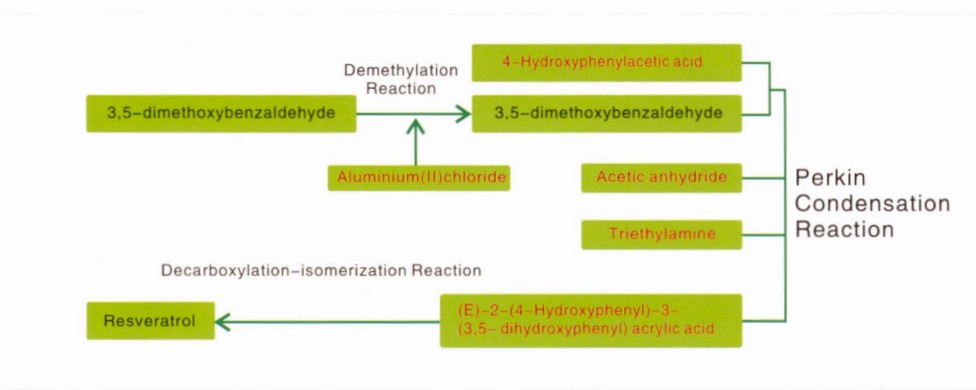If you have never heard of resveratrol before, you may get away from this page. Since you have come to this page, you must know resveratrol very well, and just want the best resveratrol. You may want to buy bulk resveratrol powder for your supplement formulas, or you just want to know some product information about resveratrol. You come to here for a reason.
Before come to the point, first let me introduce our company. Shanghai Natural Bio-engineering co., Ltd is the export branch of Hunan Keyuan Bio-products Co., Ltd, the largest manufacturer of natural resveratrol extracted from Polygonum cuspidatum in China with annual output 20 tons of resveratrol 98%, and most of the supplement brands are using our resveratrol in their formulas.
Resveratrol is becoming so popular that more and more companies are producing synthetic resveratrol in labs, factories, and manufacturing bases. Some Chinese export enterprises without morality sell synthetic resveratrol under the name of natural resveratrol as Polygonum cuspidatum extract or giant knotweed extract. Some even mix synthetic resveratrol 99% into the low spec resveratrol to make up the 50% resveratrol. Why so many Chinese companies are doing so? The answer is profit. It is greed that pushes those bad companies to fraud. The bulk price for natural resveratrol 98% is from USD270/KG to USD285/KG FOB China, while the price for synthetic resveratrol can be as low as USD210/KG.
As the largest resveratrol manufacturer, we have the obligation to expose this insider news to the public on the behalf of our clients and consumers all over the world. There is no such company do such before, and we will continue to expose other frauds inside of natural products. You may leave us message by mail for more help.
The difference between natural resveratrol and synthetic resveratrol:
Unlike natural resveratrol, synthetic versions of resveratrol are primarily made in unregulated labs in China and India using either organic chemistry, a process in which a target molecule is created from a broth of chemicals, or by fermentation, an often problematical system in which genetically modified (GMO) bacteria or yeast creates the molecule in fermentation tanks. Both methods often leave significant amounts of unknown contaminants in the resveratrol. We do not believe that the risks of using GMO derived synthetic resveratrol in our supplements is warranted simply by the obvious economic advantages of this material.

How to distinguish natural resveratrol and synthetic resveratrol?
First, we could look into the manufacturing process of synthetic resveratrol of most synthetic manufacturers:
If you could read the process, I will attach the snapshot for your reference.
According to our chemists’ guidance, they may be several methods to tell the two forms of resveratrol
Method 1:
From the above process, we do know that most of the synthetic resveratrol have the contaminants 3,5-dimethoxybenzaldehyde; Aluminium(II)chloride; 4--Hydroxyphenylacetic acid;Acetic anhydride; Triethylamine and (E )-2(4-Hydroxyphenyl)-3-(3,5- dihydroxyphenyl) acrylic acid
We can use GC-MS or HPLC-MS to detect the trace of above toxiferous contaminants.
Method 2:
We may test other contents in the resveratrol. We know that there are emodin and other natural impurities, the HPLC spectrum has different peaks at various timing.
Method 3:
We may test the proportion of cis-transveratrol and trans-resveratrol. cis-transveratrol and trans-resveratrol are the two forms of resveratrol in natural resveratrol powders. Trans-resveratrol is the active form that human is able to make use of, while the cis-transveratrol is inactive, and could not be applied. The proportion of cis-resveratrol is much higher than that of natural resveratrol powder. The optical rotation is somewhat different, too.
Method 4:
We may test the chloridion. There are large amount chloridion in synthetic resveratrol while not in the natural resveratrol.
Method 5:
Checking the carbon age in the composition of resveratrol. C14 is a good one. The age of carbon in the synthetic resveratrol is more than thousand years old, extracted from petroleum or fossil. While the carbon of natural resveratrol are absorbed from water, sun by the plant itself. And the age is within one or two years. This is the best and recommended way.
If you have any doubt, or suggestions, please send email to us for further communication.
Share to:
This article addresses:http://www.hnkeyuan.com/news/Industry News/natural-resveratrol-synthetic-resver.html
Next:Artemisinic acid: the raw material for manufacturing semi-synthetic artemisinin
Previous: Curcumin: The killer of cancer cells

